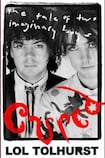
This is billed as “the inside story of The Cure by one of its founding members”. It’s nothing of the sort. Yes, Lol Tolhurst was one of the founding members of the band back in 1976 but he was sacked by Robert Smith in 1989. How much of an “inside story” can be told by a man who hasn’t been in the group for 27 years?
What this book is, though, is one of the best accounts of alcoholism you will ever come across. We begin in the “bland, dreary, greyness of the suburban swamp” that is Crawley, one of the new towns of south-east England. Tolhurst and Smith are misfits, dressing up in punk clothing that screeches “Beat Me Up Please” to the local National Front yobs.
A soundtrack of T. Rex, The Sweet and Slade (not forgetting the all-important Seasons In The Sun by Terry Jacks during the slow-set at the local disco) sets the evocative scene as our hero stumbles awkwardly through his teenage years as "the first punk in Crawley" with rancid home-brew beer and a band who couldn't play his only escape.
“I was 18 years old, I was making my own rules, it felt like my life was about to begin” says Tolhurst of The Cure’s beginning and the richness of detail of their earliest shows and their gauche naivety begins to make a serious impression.
I never knew The Cure all came from a Catholic background (dressed in black, doom and gloom, a sense of dramatic theatre – it shouldn't be a surprise really) and equally it is a surprise to find that they used to cover Thin Lizzy's Jailbreak in their early shows.
Poignant
Here the book soars – accounts of gigs in hospitals where their nascent goth sound isn't going down too well so they have to resort to playing Tie a Yellow Ribbon Round the Old Oak Tree are both poignant and hilarious. As is the fact that the band possessed just the one leather jacket – which they used to take turns wearing.
Tolhurst has a keen eye and an almost scholarly detachment from the band’s vertiginous ascent to fame. On first meeting their new manager, he notes how Chris Parry “is wearing loafers but no socks”.
“We had to fight to be heard, fight for our place on the stage, fight to be taken seriously,” he writes. It’s grim enough – having to sleep in the same bed, journeying in a vehicle not fit for purpose to venues such as the preposterously named Palm Cove in Bradford and the California Ballroom in Dunstable.
Their first single, Killing An Arab, was banned by Student Unions – it's actually about Albert Camus's The Stranger.
Whether intentionally or not, the narrative is constructed so that the reader knows before Tolhurst does that he is a bad alcoholic and this is going to end in mascara-splattered tears.
Their first time playing abroad, Tolhurst drinks so much red wine that “I am lying in the shower with water running over me trying to make sense of what had happened to me”.
Half-empty rooms
In inverse relationship with the band’s climb from playing empty rooms to half-empty rooms, Tolhurst gets involved in a picaresque selection of alcohol-related incidents and accidents. Getting badly glassed in a nightclub once, he goes to hospital to get stitches and loaded up on painkillers before returning to the nightclub to continue drinking.
It is all beautifully realised with an appealing deadpan style. A sense of numb detachment from being in a pioneering and globally successful alternative rock band only heighten the tension. From the first chapter on we know that something isn’t right – we’re just waiting to find out how wrong it can go.
The moment he is sacked from the band because of his drink problem sees an abrupt change in gear. He moves to California and seems to spend a lot of time staring at desert sunsets trying to make sense of it all.
But nothing in this latter part of the book has anywhere near the engrossing descriptive account that have gone previous.
Oddly, there isn’t really that much for The Cure fan here. But there’s a lot of “emotional repression and self-loathing”. Cure main man Robert Smith drifts in and out of the action and their once-intense, then later fractured, relationship is not this book’s main concern.
In 2011 he reunites with the band for shows at Sydney Opera House. But this Lol Tolhurst is virtually unrecognisable to us. He has been Cured.
If you're looking for a book on The Cure, try a biography. If you're looking for something along the lines of Ian Hunter's classic Diary Of a Rock 'n' Roll Star you're in the right place here.












